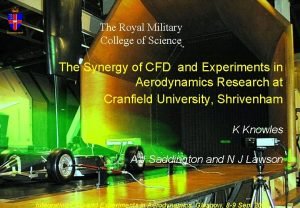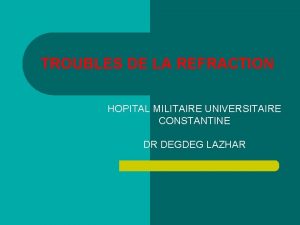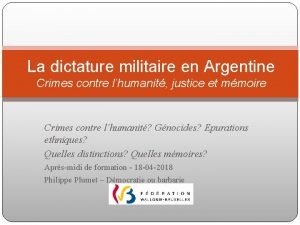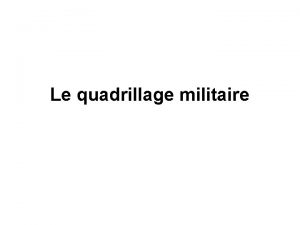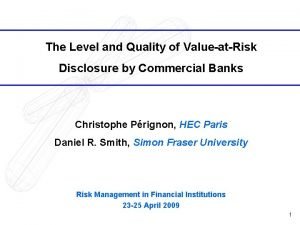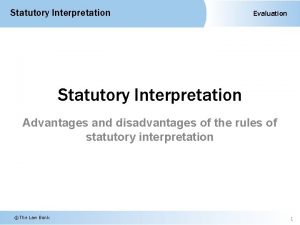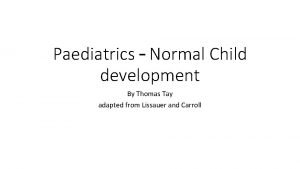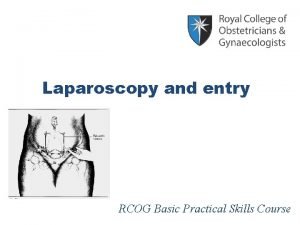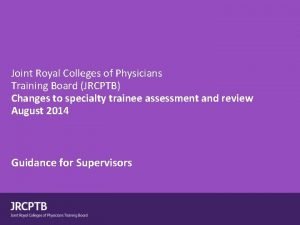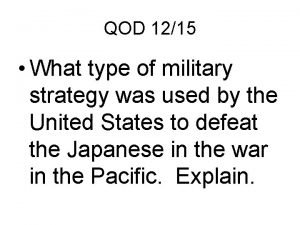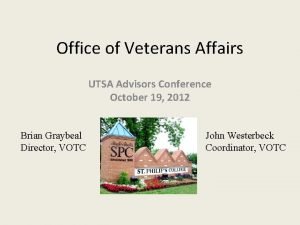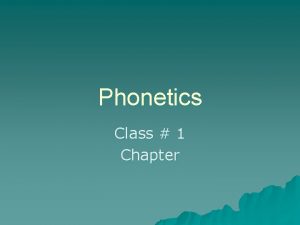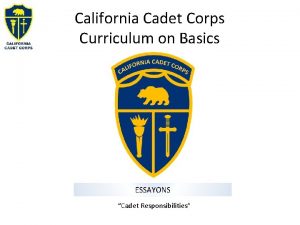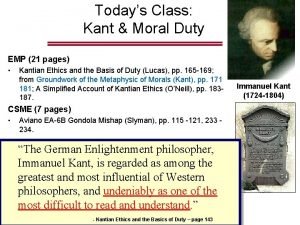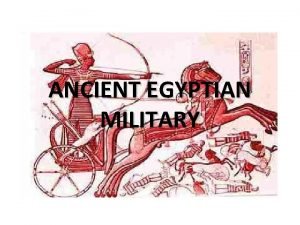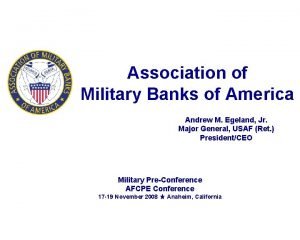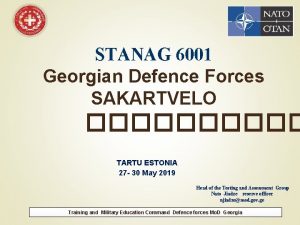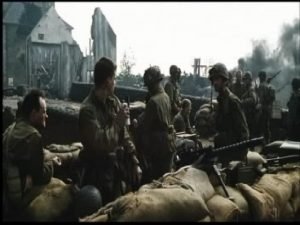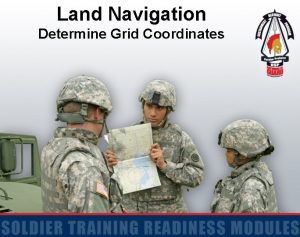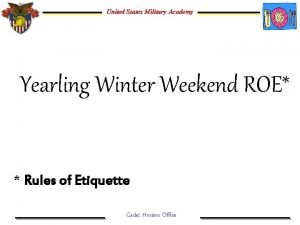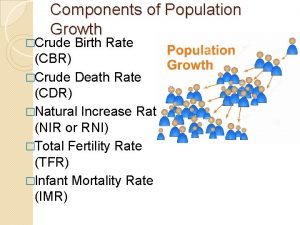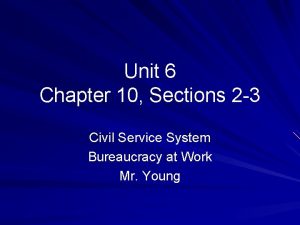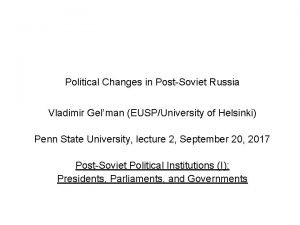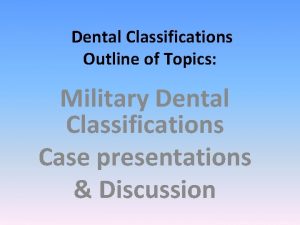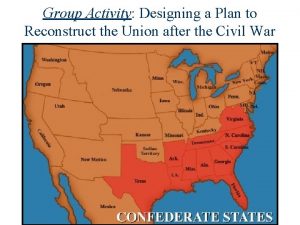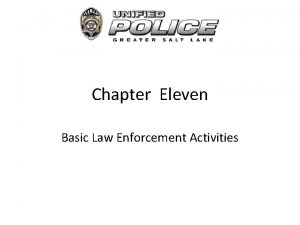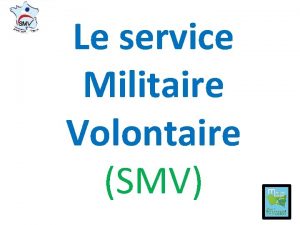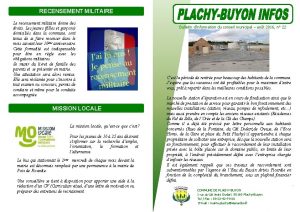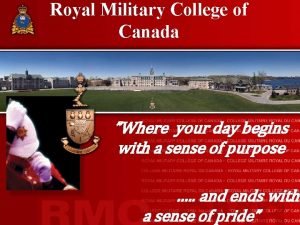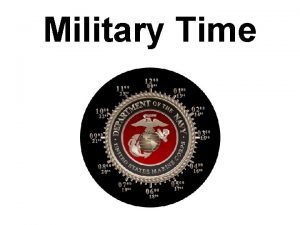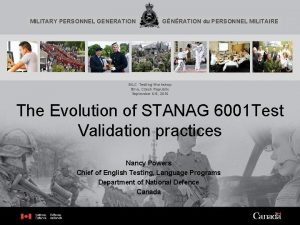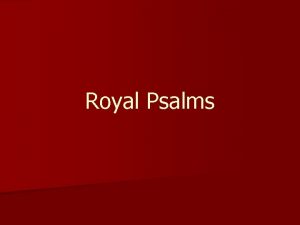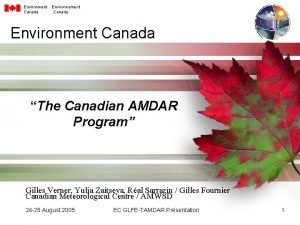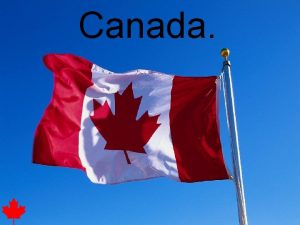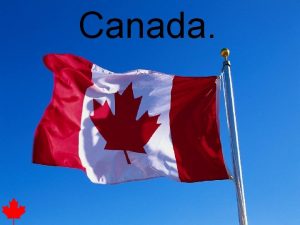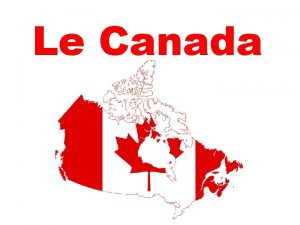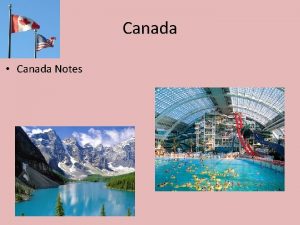Royal Military College of Canada Collge militaire royal
























































- Slides: 56

Royal Military College of Canada Collège militaire royal du Canada Dissent – Let’s Agree to Disagree Fred Cameron (Operational Analytics Canada) Jeff Appleget, Ph. D (US Naval Postgraduate School) Geoff Pond, PEng, Ph. D (Royal Military College of Canada) Contact: Fred. Cameron@Op. Analytics. ca















Wanted: A Methodical Way to “Organize” Dissent

Ranks and Rank Correlation • Two judges rank n objects • As a ranking each judge provides a permutation of the numbers 1. . . n • Kendall’s provides a correlation coefficient for a pair of judges • Kendall’s extension covers judges with ties • Kendall provides statistical tests of significance • A transformation of τ gives distance: (1 - τ)/2

Examples τ=1 d=0 τ = -1 d=1 τ = -0. 11 d = 0. 56

The Problem of m Rankings • Judges: m Objects: n • Each judge provides a permutation of 1. . . n (if no ties) • Extension allows a judge to submit ties: – 1 1 ► 2½ 2½ • Coefficient of Concordance: W W = 0. 828 F = (m-1) W / (1 -W), ν 1 = n – 1 – 2/m, ν 2 = (m-1) v 1 χr 2 = m (n-1) W, ν = n-1 Source of example: MG Kendall, Rank Correlation Methods, 4 th ed. , Griffin, London, 1970

Kendall’s Cautions “The provision of the above tests of significance [F test and 2 test of W] should not be allowed to obscure the desirability of examining the primary data to see if there any obvious effects present. ” “When a number of observers are suspected a priori to be heterogeneous in their tastes, it may obscure meaningful effects to assemble their rankings into a single group. ” Source: M. G. Kendall, Rank Correlation Methods, 4 th ed, Griffin, London, 1970, Sect 6. 15

Kendall’s “Extreme Case” For J 01 to J 20 W=0 Conclude: “No community of preference” But For J 01 to J 10, W = 1 For J 11 to J 20, W = 1 “The community of one set of observers has completely masked that of the other. ”

Alternatives for Group Ranking • • Rank sums or Borda count Condorcet voting Scores followed by weighted sums Analytic Hierarchy Process (AHP) • But we will use rank sums for the examples

Kendall’s Simple Example

Raw Ranks and Standardization

Analysis of Kendall’s Example

Cluster Analysis and Multidimensional Scaling Map borda R P d hclust (*, "average") -0. 04 -0. 020. 00 0. 02 0. 04 0. 06 0. 08 Q 0. 14 0. 10 0. 06 distance 0. 18 Cluster Dendrogram R borda Q P -0. 15 -0. 10 -0. 05 0. 00 0. 05 0. 10 0. 15

Second Example – Raw Ranks

Kendall’s W with p-value

Scaled Ranks with Group Ranking by Borda (and Reordered)

Pairwise Tau Coefficients

Pairwise Distances

Cluster Analysis and Multidimensional Scaling J 7 0. 2 0. 3 0. 0 0. 1 0. 2 0. 3 0. 4 0. 5 0. 6 0. 1 J 3 J 2 -0. 1 0. 0 J 6 J 5 J 1 J 7 J 2 J 3 borda J 4 J 8 distance 0. 4 Cluster Dendrogram borda J 8 J 4 -0. 4 d hclust (*, "average") J 1 J 5 J 6 -0. 2 0. 0 0. 2 0. 4

The Four Agreeable Judges

Cluster Analysis and Multidimensional Scaling Cluster Dendrogram 0. 00 -0. 05 borda J 4 J 8 J 2 J 3 distance 0. 05 0. 10 0. 15 0. 05 J 2 J 4 J 8 borda J 3 -0. 15 -0. 10 -0. 05 0. 00 0. 05 0. 10 0. 15 d hclust (*, "average")

Four Other Judges

Cluster Analysis and Multidimensional Scaling d hclust (*, "average") -0. 10 -0. 05 0. 00 0. 05 0. 10 0. 15 borda J 6 J 5 J 1 J 7 0. 25 0. 30 0. 35 0. 40 distance Cluster Dendrogram J 1 J 5 J 7 -0. 3 J 6 borda -0. 2 -0. 1 0. 0 0. 1 0. 2

Conclusion Please TRY this at home!

R Script for Schools of Thought Analysis f <- file. choose() #get filename rr <- read. csv(f, row. names=1) #read file of judges' raw ranks sr <- apply(rr, MARGIN=2, rank) #scale to canonical form rs <- row. Sums(sr) #calculate rank sum borda <- rank(rs) #generate ranks for borda sr <- sr[, order(-cor(sr, borda, method="kendall"))] #reorder by agreement with borda srb <- cbind(sr, borda)[order(borda), ] #bind borda to judges' ranks w <- kendall(sr, correct=TRUE) #determine coeff concordance tau <- cor(srb, method="kendall") #calculate tau matrix d <- as. dist((1 -tau)/2) #calculate distances ca <- hclust(d, method="average") #determine cluster config mds <- cmdscale(d) #determine mds config x <- mds[, 1] #extract x coord for mds y <- mds[, 2] #extract y coord for mds plot(ca, ylab="distance") #plot hierarchical clusters plot (x, y, type="n", xlab="", ylab="", xlim=range(x)*1. 2, ylim=range(y)*1. 2) #set frame for mds map text(x, y, rownames(mds)) #add judge names to mds map

File of Raw Rankings , P, Q, R A, 1, 2, 2 B, 4, 1, 1 C, 2, 2, 4 D, 3, 4, 4 E, 4, 4, 4 F, 7, 8, 4 G, 6, 9, 8 H, 9, 6, 8 I, 7, 10, 8 J, 10, 6, 10 Note: 1. File is contains comma separated variables (CSV) with three judges and ten objects 2. File has labels in first row and first column 3. R will use only order: < > = 4. So, multiple 4’s will be treated as ties 5. No need to put ranks into canonical (standardized) form

Theory with Examples • Now in 3 rd edition, with about 100 additional pages • Chapter 17 on Multidimensional Scaling • Chapter 18 0 n Cluster Analysis

Royal Military College of Canada Collège militaire royal du Canada Questions and Answers (maybe) Also: Digressions, if time permits

Analytic Hierarchy Process – Two Choices • (1) Convert AHP scores to ranks and proceed as described • (2) Take each AHP score as a vector in nspace and use some definition of distance: – Pearson correlation or vector difference • Then proceed with cluster analysis and multidimensional scaling

The Alternatives Eight judges (J 1 to J 8) evaluated the following alternatives Source: The Technical Cooperation Program. Technology Requirements for Soldier Modernisation in the 2015 Timeframe JSA-AG 7 -2000 -01, TTCP, Washington, DC, 2000

AHP Results by Participant


Pairwise Pearson Correlation Coefficients

Cluster Analysis and Multidimensional Scaling Map 0. 2 0. 1 J 3 J 4 J 1 0. 0 0. 2 -0. 1 J 8 J 3 J 5 -0. 3 J 8 J 5 J 4 J 2 group J 7 d hclust (*, "average") J 7 J 2 J 6 group J 6 0. 1 0. 0 distance 0. 3 0. 4 Cluster Dendrogram -0. 4 -0. 2 0. 0 0. 2

R Script for AHP, part 1 f <- file. choose() #get filename ahp <- read. csv(f, row. names=1) #read file of ahp scores group <- ahp[ , length(ahp)] #get group scores only (last column) ahps <- ahp[ , -length(ahp)] #get participant ahp scores only ahps <- ahps[ , order(-cor(ahps, group))] #reorder by agreement with group ord <- cbind(ahps, group)[order(-group), ] #bind participants scores to group pcor <- cor(ord) #calculate pearson cor matrix d <- as. dist((1 -pcor)/2) #calculate distances ca <- hclust(d, method="average") #determine cluster config mds <- cmdscale(d) #determine mds config x <- mds[, 1] #extract x coord for mds y <- mds[, 2] #extract y coord for mds plot(ca, ylab="distance") #plot hierarchical clusters plot (x, y, type="n", xlab="", ylab="", xlim=range(x)*1. 2, ylim=range(y)*1. 2) #set frame for mds map text(x, y, rownames(mds)) #add judge names to mds map

R Script for AHP, part 2 #repeat Schools of Thought Analysis with ahp scores converted to rankings sr <- apply(-ahps, MARGIN=2, rank) #scale to canonical form rs <- row. Sums(sr) #calculate rank sum borda <- rank(rs) #generate ranks for borda sr <- sr[, order(-cor(sr, borda, method="kendall"))] #reorder by agreement with borda srb <- cbind(sr, borda)[order(borda), ] #bind borda to judges' ranks w <- kendall(sr, correct=TRUE) #determine coeff concordance tau <- cor(srb, method="kendall") #calculate tau matrix d <- as. dist((1 -tau)/2) #calculate distances ca <- hclust(d, method="average") #determine cluster config mds <- cmdscale(d) #determine mds config x <- mds[, 1] #extract x coord for mds y <- mds[, 2] #extract y coord for mds plot(ca, ylab="distance") #plot hierarchical clusters plot (x, y, type="n", xlab="", ylab="", xlim=range(x)*1. 2, ylim=range(y)*1. 2) #set frame for mds map text(x, y, rownames(mds)) #add judge names to mds map

Myths and Myth-busting • If we can agree on the facts, then we will agree on the decision – So, there should be no dissent • “If everyone is thinking alike, then somebody isn't thinking. ” General George S. Patton

Anscombe’s Quartet Set 1

Anscombe’s Quartet Set 2

Anscombe’s Quartet Set 3

Anscombe’s Quartet Set 4

We Need “Pictures”

Royal Military College of Canada Collège militaire royal du Canada Questions – Comments
 Royal military college of science
Royal military college of science Cadbury collge
Cadbury collge Everest collge
Everest collge Collgeen
Collgeen Hopital militaire constantine
Hopital militaire constantine 9 rama treves
9 rama treves Militaire
Militaire Hopital militaire constantine
Hopital militaire constantine Kruistocht
Kruistocht Quadrillage militaire
Quadrillage militaire Royal bank of canada
Royal bank of canada Advantages of the mischief rule
Advantages of the mischief rule Group 2 specialties
Group 2 specialties Thomas tay
Thomas tay Aids to statutory interpretation
Aids to statutory interpretation Rcog basic practical skills
Rcog basic practical skills Royal college of occupational therapists
Royal college of occupational therapists Jcrptb
Jcrptb Asd college college readiness program
Asd college college readiness program Early college high school at midland college
Early college high school at midland college 9 line medevac scenario example
9 line medevac scenario example Lisa osborne body attack
Lisa osborne body attack Campaign english for the military
Campaign english for the military Qod12
Qod12 Battle 216 bc
Battle 216 bc Utsa military affairs
Utsa military affairs Phonetic alphabet song military
Phonetic alphabet song military Wren njrotc
Wren njrotc Essayons meaning
Essayons meaning Jet cuts cable car
Jet cuts cable car Origin
Origin Association of military banks of america
Association of military banks of america Language background
Language background Military salute
Military salute Dli ecl
Dli ecl Military branches
Military branches Kgx-93
Kgx-93 Military ethos
Military ethos How to determine grid coordinates on a military map
How to determine grid coordinates on a military map Armed forces military
Armed forces military Map overlay usmc
Map overlay usmc Operation military embrace
Operation military embrace Air force talking paper example
Air force talking paper example Yearling winter weekend
Yearling winter weekend Catering segments
Catering segments Spanish alphebet song
Spanish alphebet song Identify strategic opportunities
Identify strategic opportunities Army decision brief powerpoint examples
Army decision brief powerpoint examples Military courtesy definition
Military courtesy definition Skeleton stabbing heart flag
Skeleton stabbing heart flag Excessive military spending in rome
Excessive military spending in rome Military base population pyramid
Military base population pyramid Victorious politicians rewarding of their followers
Victorious politicians rewarding of their followers Russian military branches
Russian military branches Dental class 1 2 3
Dental class 1 2 3 Military district reconstruction
Military district reconstruction Military and law enforcement
Military and law enforcement
